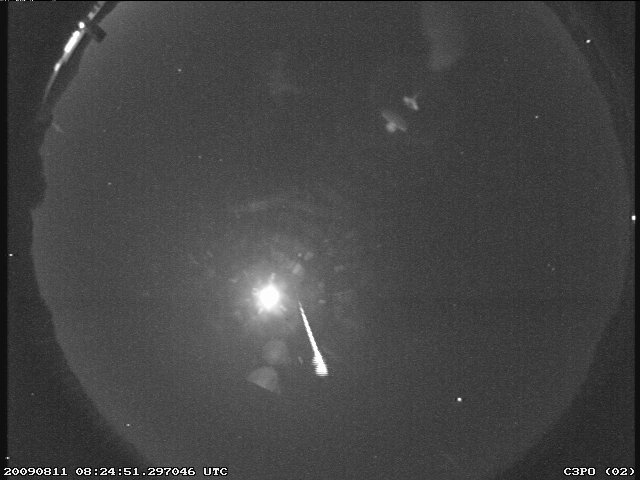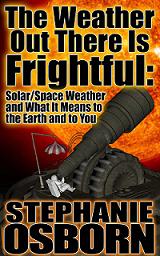http://www.stephanie-osborn.com
SOLAR UPDATE:
The Sun has definitely awakened for the time. (Finally.) There are currently half a dozen spot groups on the solar near side; 2571 is about to rotate to the far side, but there are also 2573-7 as well, which range from a simple single spot to a multi-spot complex.
 |
| Solar Dynamics Observatory imagery Labeling by Solarham.com |
Very minor C-class flares are occurring, but there is little chance for anything stronger. A filament did lift, and this may produce a small coronal mass ejection, or CME. We're waiting on LASCO (Large Angle and Spectrometric Coronagraph, an instrument on SOHO, the Solar and Heliospheric Observatory) imagery to determine if it made a CME or not. Such CMEs tend not to be as strong as those associated with large flares, so even if it is Earth-directed, expect pretty aurorae and a few high-latitude effects, but nothing of significance.
There are some coronal holes, but they aren't "geoeffective" (aimed at Earth). Geomagnetic activity is quiet.
 |
| Solar Dynamics Observatory imagery Labeling by Solarham.com |
More data as it comes in.
* * *
PERSEID METEOR SHOWER:
Well, the night of August 11/12 was the absolute peak of the Perseids. I've just come in from spending about 20 minutes outside, having a look. (It's currently 4am local time.)
I have to say that I was underwhelmed, especially given the hype given to the predictions of "up to 200 meteors/hour." That comes out to be over 3 meteors per minute, or about one meteor every 15-20 seconds. So in 20 minutes, I should have seen around 66 meteors.
I saw about 1/10 that.
Now, granted, I'm in a subdivision and my skies are not the darkest. And we had some light patchy clouds moving through. But I waited until after the moon had set before I went out, to have the darkest possible skies for my location. And I picked the clearest patches of sky to observe, and ensured I blocked any light sources. Keep in mind that I've observed this shower from this location numerous times before, as well, so I know what I'm looking for. And I've seen the Perseids storm, the year after the parent comet, Swift-Tuttle, came through -- both from a rural dark-sky site, and my yard, where I was tonight.
 |
| Bill Cooke, NASA Meteoroid Environment Office, Huntsville, AL August 10, 2009 |
I undoubtedly would have seen more meteors had I been in a dark-sky site. But ten times more? Really?
It's possible, also, that I simply picked a time when, coincidentally, we were going through a sparse patch -- I was busy writing, and lost track of time, or I'd have been out there earlier, for longer. I'll be interested to see what other observers have to say.
As for me -- I love the Perseids; they're gorgeous, bright fireball meteors. But this didn't come anywhere close to the spectacle I remember right after Swift-Tuttle came through. That was one I'll always remember. Tonight, not so much.
If you were out observing the Perseids, I'd love to hear your observations in the comments.
* * *
BOOK RECOMMENDATIONS:
 For more information on solar activity, check out my ebook, The Weather Out There Is Frightful: Solar/Space Weather and What It Means for the Earth and You.
For more information on solar activity, check out my ebook, The Weather Out There Is Frightful: Solar/Space Weather and What It Means for the Earth and You.
Just a quick promo for me and my fellow scientists, for those of you who are interested in such things: A new anthology will be released in September (we hope!) called Science Fiction By Scientists. Every short story in it is "hard SF" written by an actual scientist, along with a quick primer at the end of each story on the science involved. It's available for preorder now!
~Stephanie Osborn
http://www.stephanie-osborn.com

8 comments:
ADDITIONAL PERSEIDS UPDATE: According to what I am reading on the international Comet mailing list, there MAY have been a very brief "storm" level outburst that reached near the predicted maximum of 200/hr. However, data is still coming in. IF it indeed reached the max, it sounds like it did so for an hour or less, and it occurred during daylight hours in the Western Hemisphere. European observers were well placed to view it, and possibly western Asian, but US observers wouldn't have seen it at all.
Also some observers are claiming the peak to be the night of Aug 12/13, rather than 11/12, and are wanting to wait and see. I'll try to go back out again tonight and have another look.
There are other evenings which have traditionally produced Perseid outbursts. Unfortunately one of the automated stations, which would have caught any, is offline due to a hacking attack.
Ham radio operators are picking up the plasma from the meteors' passage, and report that there is increased activity, though it is very sporadic. These are not, however, visual observations.
I went outside about 11 PM. I'm on a farm with dark skies. I saw 4 in about 15-20 minutes. Oh well. Maybe next year.
Yes, Samuel, that seems to be pretty consistent.
And no, it isn't likely to have more next year. Meteor "storms" are relatively rare.
Not everyone in the astronomical community agreed with the 200/hr prediction, it seems. But of course that's what the news media grabbed and ran with. Which is why I really get annoyed with predicting things like "the greatest comet this century" and the like -- we DON'T KNOW. There are some things we can predict, and other things we can say we THINK might happen. But then lay people hear the hype in the media, and when it doesn't happen, they get turned off astronomy totally. That really bugs me.
Meteors always seem to conspire against me. When I'm watching for them, they're always few and far between, as well as fast-moving and short-lived.
When I'm not looking for them, they ambush me, like the green one that came WAY down near the horizon before petering out, several weeks ago, or the bolide that went over while I was riding in the back of a pickup truck, almost asleep, about 30 years ago.
Yes. But there is a trick to watching a meteor shower. Locate the radiant in the sky (in this case, Perseus tends to be in the NE, lower in the earlier hours, higher as the night progresses) and turn your shoulder or even your back to the radiant. You'll get much longer tracks that way, with more chance to spot.
Think of it like this: You are driving in a snowstorm. If you are looking straight ahead, you see the snowflakes coming right at you, and you see little except the fact that the tiny dot gets bigger until it splats on your windshield. If you look out the side window, you see the streak as the snowflake blows past. If you look out the back, you can see long trails disappearing in the distance. Same concept with meteor showers. If you look at the radiant, you're "staring forward into the windshield." So look AWAY from the radiant.
I have seen red/green meteors IN THE DAYTIME. I've actually seen several meteors in the daylight. Those are pretty spectacular.
Thank you for your coverage on the meteors. I am disappointed I read your posts on the Perseids today, rather than earlier - I just followed link from Mad Genius Club today). Last night I was watching in the exact wrong direction due to a misleading news story, and tonight promises to be cloudy. I did sight about 7 meteors in thirty minutes, but I could only see them for maybe 2-3 seconds as they flitted past. If tonight clears up at all I'll have to make another try.
If you saw meteors that lasted for 2-3 seconds, you saw some good meteors. These are very short in time, folks. Think the universe's fireworks. Occasionally, especially with this shower, you'll get "spangles" that last a while in the wake, again like fireworks. But any given meteor in a shower isn't going to last a long long time.
I spotted about 6-7 meteors in about 20 minutes, about half of which were close to the limit of my ability to see, but as I said in the main body of the blog article, this was only about 1/10th of the rate that was predicted.
..."Last a while" translates to another couple of seconds, though.
And I am glad I could help. We have easily another week or so in which the meteor shower can be seen, so don't give up seeing them just because the peak is passing, or has passed.
Post a Comment